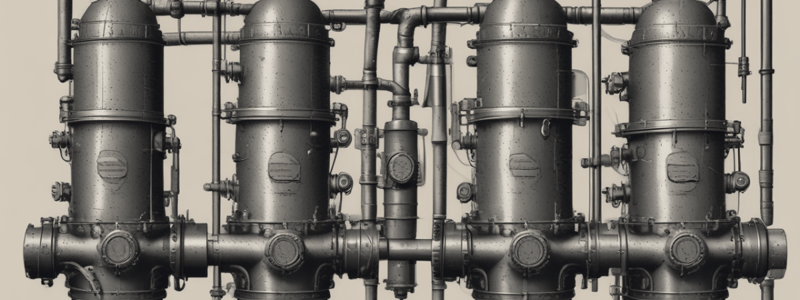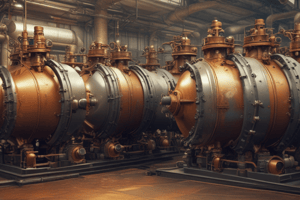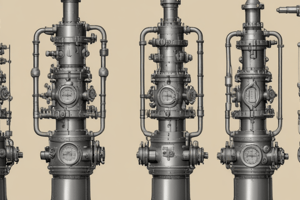Podcast
Questions and Answers
What is the purpose of a try lever test on a pressure relief valve?
What is the purpose of a try lever test on a pressure relief valve?
- To determine if the valve will open at its set pressure
- To repair or replace the valve
- To check if the valve is operating freely (correct)
- To perform an accumulation test
How often are try lever tests performed on steam heating boilers?
How often are try lever tests performed on steam heating boilers?
- Monthly (correct)
- Annually
- Every six months
- Every three months
What is the minimum pressure required to perform a try lever test on a steam heating boiler?
What is the minimum pressure required to perform a try lever test on a steam heating boiler?
- 10 kPa
- 35 kPa (correct)
- 20 kPa
- 50 kPa
What should be done if a valve continues to simmer after a try lever test?
What should be done if a valve continues to simmer after a try lever test?
What is the purpose of a pop test?
What is the purpose of a pop test?
How often should pop tests be performed?
How often should pop tests be performed?
What is recorded during a pop test?
What is recorded during a pop test?
What is used to determine if a safety valve is operating properly during a pop test?
What is used to determine if a safety valve is operating properly during a pop test?
Flashcards are hidden until you start studying
Study Notes
Pressure Relief Valve Maintenance
- Pressure relief valves must be kept in good working condition at all times and tested regularly to ensure proper functioning.
Try Lever Test
- The try lever test determines if a pressure relief valve is operating freely, but not if it will open at its set pressure.
- The test is performed:
- Monthly on steam heating boilers
- Every three months for hot water heating boilers
- Every six months on power boilers operating below 2760 kPa
- Prior to pop tests and accumulation tests
- Boiler pressure must be:
- 35 kPa or higher for steam heating boilers
- At least 75% of the safety valve setting for power boilers
- The test procedure:
- Pull the try lever to the wide-open position
- Allow steam to discharge for 5-10 seconds
- Release the lever
- Allow the spring to snap the valve disc to the closed position
- If the valve simmers, operate the try lever 2-3 times to allow the disc to seat properly
Pop Test
- The pop test checks the full operation of the safety valve, including the exact pressures at which it opens and closes.
- The test procedure:
- Increase the boiler steam pressure to the safety valve set point
- Record the opening and reseating pressures accurately
- Compare the opening pressure and blowdown to the ASME BPVC performance tolerances
- The pop test should be performed annually, before taking a boiler off-line for maintenance.
- Defective valves can be identified and replaced or repaired prior to the boiler re-entering service.
Repair and Adjustment
- Repair or adjustment of pressure relief valves must be done by the valve manufacturer or its authorized repair representative.
- Consult the relevant ASME BPVC sections and the local Boiler Inspector to determine who is qualified to adjust or repair PRVs in a particular jurisdiction.
Studying That Suits You
Use AI to generate personalized quizzes and flashcards to suit your learning preferences.




